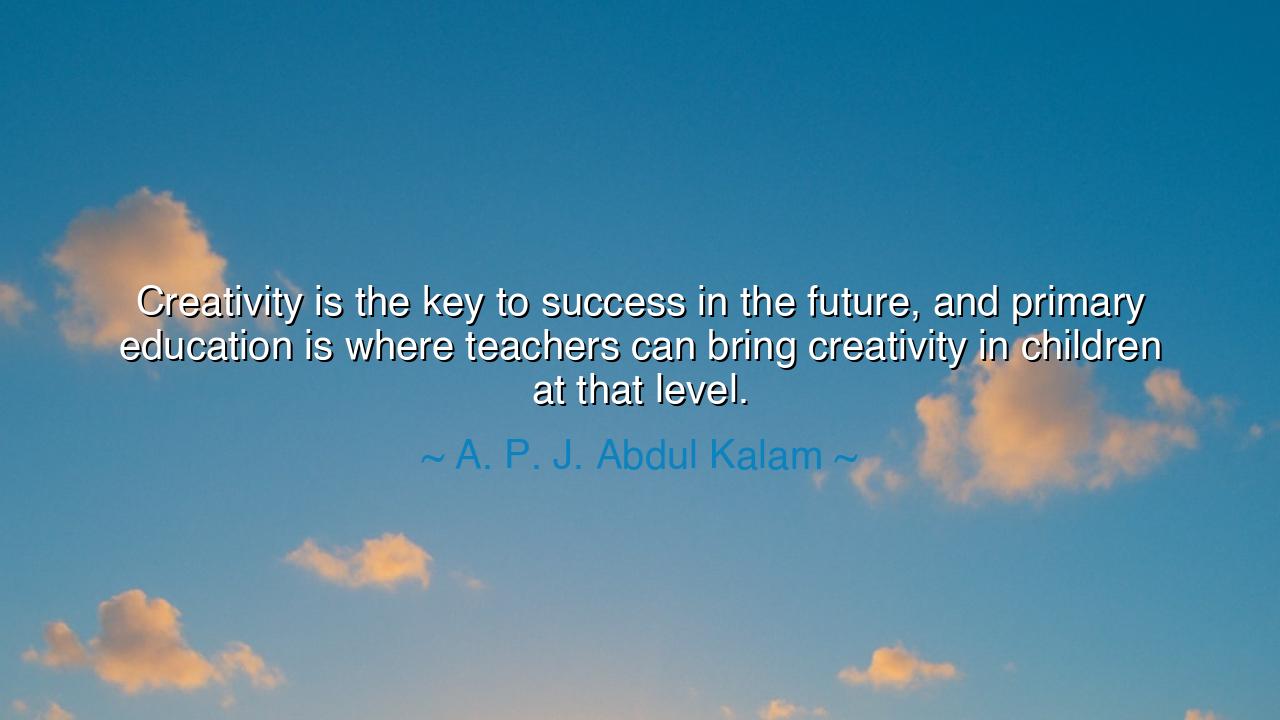
Creativity is the key to success in the future, and primary
Creativity is the key to success in the future, and primary education is where teachers can bring creativity in children at that level.






"Creativity is the key to success in the future, and primary education is where teachers can bring creativity in children at that level." These words by A. P. J. Abdul Kalam are a powerful reminder of the foundational importance of creativity in shaping not only the future of individuals but of entire societies. Kalam recognized that in a world of constant change, the ability to think creatively, to solve problems in innovative ways, and to approach challenges with an open mind would be the defining characteristic of those who would lead in the future. At its core, creativity is not just about artistic expression; it is about thinking outside the box, seeing the world through new lenses, and creating solutions where none seemed possible.
In the ancient world, the role of education and creativity was also deeply valued. The Greek philosophers, such as Socrates and Plato, were not only concerned with the transmission of knowledge but with the cultivation of the mind’s ability to question, innovate, and explore. Socrates, through his method of questioning, encouraged his students to think critically, not merely accepting the world as it was but to reimagine it. Similarly, Plato emphasized the importance of imagination in his works, arguing that the ideal society would be one that nurtures both the intellectual and creative capacities of its citizens. In this way, the ancients understood that true wisdom was born not just from facts, but from the ability to create new ways of thinking and living.
This deep connection between creativity and education forms the bedrock of Kalam’s vision. In his eyes, primary education is where the seeds of creativity are planted, where children’s minds are first exposed to the wonders of imagination and problem-solving. He understood that the early years of a child’s life are the most crucial, for they shape the foundations upon which all future learning is built. It is during these formative years that a child’s curiosity is nurtured, where exploration and wonder become second nature, and where a teacher’s influence can open doors to a world of limitless possibilities. If children are encouraged to think creatively at a young age, they will grow into adults who approach the world not with limitations, but with an unwavering belief in the power of innovation.
Consider the example of Leonardo da Vinci, whose creativity transcended the boundaries of art, science, and engineering. Da Vinci was a man who was not confined to one discipline but saw the connection between all things, drawing upon his diverse interests to fuel his creative genius. As a child, he was encouraged to observe the world around him and to question it—traits that were encouraged in the Renaissance as a whole, where curiosity and creativity were seen as essential to understanding and shaping the world. Da Vinci’s work in anatomy, engineering, and art was a direct reflection of his creative thinking, which was nurtured early on and encouraged throughout his life. His story reminds us that creativity is not confined to the arts but is a force that drives discovery and progress in all fields.
The lesson that Kalam imparts is both simple and profound: the future belongs to those who create, and that creativity must be nurtured from the very beginning. Education is not just about transmitting knowledge but about inspiring young minds to imagine, to innovate, and to challenge the status quo. By cultivating a creative mindset in children, we equip them with the tools to succeed in a world that will demand new ideas and solutions. This is why the role of the teacher is sacred—because they have the power to ignite the spark of creativity and curiosity that will guide children throughout their lives.
In our own time, we must recognize that creativity is not a luxury or an optional extra in education, but an essential skill for navigating an increasingly complex world. We must support teachers who are capable of fostering this creativity, creating environments where children are encouraged to experiment, explore, and embrace failure as a part of the learning process. Just as Socrates believed that questions were more important than answers, we must allow children the freedom to ask and to explore without fear of being wrong. It is through this process of exploration that innovation is born.
Thus, the message is clear: the future is not something that can be passively accepted; it must be actively created. Kalam’s vision calls on all of us—educators, parents, and society—to play an active role in fostering the creative potential of every child. If we are to build a world of progress and possibility, it is up to us to ensure that creativity is nurtured from the start, so that the leaders, thinkers, and innovators of tomorrow are equipped with the most powerful tool of all: an open, creative mind. Let us embrace this responsibility, for the future is not a destiny written in stone, but a world we have the power to shape through imagination, creativity, and bold action.






AAdministratorAdministrator
Welcome, honored guests. Please leave a comment, we will respond soon